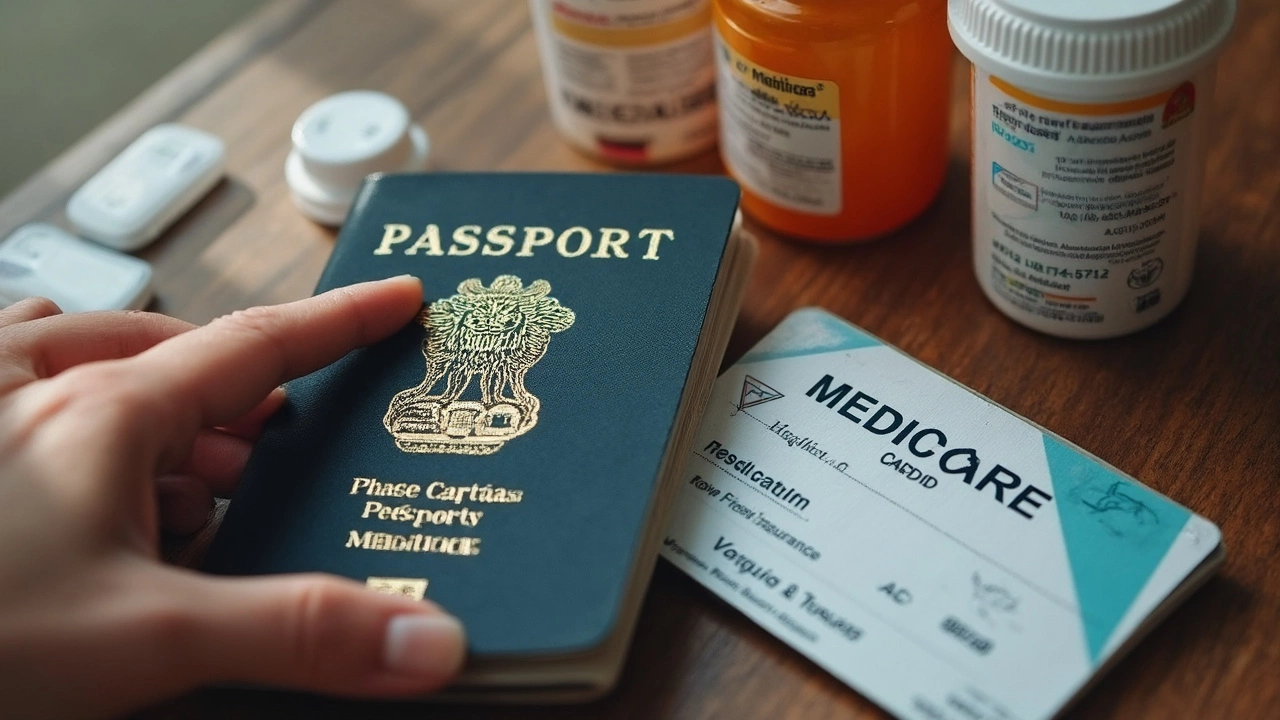-
19

Does Medicare Cover You Overseas? What Every Traveler Needs to Know
Ready to see the world? You’ll want to stop and check your Medicare card before you start packing. Here’s the reality: Original Medicare (that’s Part A and Part B) doesn’t follow you to most countries outside the U.S. People are shocked when they hear this—especially since even a quick trip to Paris or a beach escape in Thailand could cost thousands if something goes wrong and you need a doctor.
It sounds unfair, but Medicare’s rulebook says ‘no’ to almost all overseas claims. If you end up in a foreign hospital, don’t expect Uncle Sam to cover the bill. Even simple things—like an infection, a broken ankle, or a surprise appendix attack—won’t be covered by standard Medicare.
What about Medicare Advantage or Medigap plans? That’s a gray area. Some Advantage (Part C) and certain Medigap (like Plan G) policies might toss in limited coverage for emergencies while you’re outside the U.S., but the fine print can get tricky. Limits, deductibles, special requirements—the devil’s in the details. Before you trust these plans, call your provider and grill them about what’s reasonable and what’s just marketing fluff.
- The Truth About Medicare Coverage Abroad
- Rare Exceptions: When Medicare Actually Pays Overseas
- Travel Insurance: Bridging the Coverage Gap
- Pro Tips Before You Pack Your Bags
The Truth About Medicare Coverage Abroad
If you're on Medicare and thinking about leaving the country, here’s the headline: standard Medicare overseas coverage is almost non-existent. Original Medicare—that’s the typical Part A (hospital) and Part B (medical)—pretty much locks its doors at the U.S. border, including places you’d think might count, like Puerto Rico and Guam. Those are covered, but step into Canada or Mexico, and it’s a hard no.
The Centers for Medicare & Medicaid Services makes this super clear. If you're in a hospital outside the U.S., Medicare won’t pay—even if it’s an emergency. This rule surprises a lot of folks, especially snowbirds or world travelers. According to a Medicare Rights Center survey, over half of Medicare enrollees didn’t know this coverage gap existed.
So, where exactly is Medicare accepted? Besides all 50 states, it covers you in the District of Columbia, Puerto Rico, the U.S. Virgin Islands, Guam, the Northern Mariana Islands, and American Samoa. That’s it. Cross into Canada for a quick trip or go on a river cruise in Europe, and Medicare offers zero regular protection for medical bills you rack up there.
Just to clear up confusion, Medigap and Medicare Advantage sometimes advertise extra Medicare travel perks, but don’t count on that as your safety net. Most of the time it’s either for emergency coverage only, or it’s capped with lots of hoops to jump through. We’ll get into details later.
Here’s a quick look at where Medicare travel coverage applies and doesn’t apply:
| Location | Standard Medicare Coverage? |
|---|---|
| USA (all states) | Yes |
| District of Columbia | Yes |
| Puerto Rico, Guam, USVI, American Samoa, Northern Mariana Islands | Yes |
| Mexico, Canada, Europe, Asia, Africa, etc. | No |
If you have a chronic condition, need prescriptions, or expect any kind of medical care, plan ahead before you travel. The last thing you need is a medical emergency and a fat hospital bill in a foreign language.
Rare Exceptions: When Medicare Actually Pays Overseas
So, does Medicare overseas coverage ever kick in? Surprisingly, yes—but only in situations that feel more like legal loopholes than true travel perks. It’s rare, but knowing these could save your wallet if you find yourself in a bind.
Here are the main times Original Medicare might pay for emergency care outside the U.S.:
- Border hospital rule: If you’re traveling in the U.S. but need hospital care and the closest option is actually in Canada or Mexico, Medicare may cover it. Think about people in northern states, near the Canadian border—sometimes the nearest emergency room is across the border.
- Traveling through the U.S. to another country: If you have a medical emergency while traveling directly between Alaska and another U.S. state and the shortest route takes you through Canada, Medicare could cover hospital care in Canada if that’s where you get sick or hurt and a U.S. hospital is too far away.
- On a cruise: Emergency care may be covered if your ship is in U.S. territorial waters (within six hours of a U.S. port). But as soon as you’re beyond that distance, you’re out of luck.
How much do these exceptions actually matter? Let’s be honest—most folks won’t find themselves needing an ER in a Canadian border town, or on a cruise just outside Miami. But if you live in a border state or plan a one-of-a-kind trip that fits these odd rules, it’s worth keeping receipts and medical records handy just in case. Medicare will require proof that your situation fit their tight guidelines.
| Situation | Is Medicare Coverage Available? |
|---|---|
| Emergency in Canada near U.S. border | Yes |
| Medical event during cruise in U.S. waters | Yes (if within 6 hours of U.S. port) |
| Routine care anywhere outside U.S. | No |
| Emergency flying between continental U.S. and Alaska through Canada | Yes |
Bottom line? Don’t count on these rare loopholes unless you know your trip fits the rules perfectly. Always confirm details with Medicare before your journey.

Travel Insurance: Bridging the Coverage Gap
If you’re relying on Medicare overseas coverage, you’re mostly out of luck. That’s where travel insurance comes to the rescue. You’ll see travel insurers talking up “emergency medical” coverage for good reason—it’s the only realistic way to avoid huge out-of-pocket costs if you get sick or hurt outside the U.S.
Travel insurance isn’t just for older travelers. Medical emergencies anywhere, whether it’s food poisoning in Italy or a scooter crash in Thailand, don’t discriminate by age. What makes a difference is having a solid policy that specifically covers medical care abroad, not just lost luggage and delayed flights.
Here’s what you need to look for when picking a plan that plugs the giant holes left by Medicare travel limits:
- Check if the plan covers pre-existing conditions. Some plans exclude these or make you jump through hoops (like buying insurance within two weeks of your first trip payment).
- Look at coverage limits for medical expenses. $100,000 in coverage is a common minimum—and it’s not overkill if you end up in a private hospital.
- Check for emergency evacuation coverage. Getting flown back to the U.S. for treatment can cost upwards of $100,000.
- Don’t forget 24/7 support. The best plans offer round-the-clock help if you need to find a hospital or don’t speak the language.
Here’s a quick snapshot of what travel insurance typically offers compared to Medicare travel coverage. You’ll see why most savvy travelers grab a plan:
| Coverage | Original Medicare | Travel Insurance |
|---|---|---|
| Overseas medical emergencies | No | Yes |
| Evacuation back to the U.S. | No | Usually |
| Pre-existing conditions | No | Sometimes |
| COVID-19 treatment | No | Varies by plan |
Pro tip: Most big travel insurance companies, like Allianz, World Nomads, and IMG, sell policies you can buy in minutes online. In 2024, the average cost of travel medical coverage for a senior was about $4–$8 per travel day—not bad considering a single ER visit could wipe out your vacation budget (and then some).
Pro Tips Before You Pack Your Bags
Don’t get on that plane without doing a quick reality check on your health coverage. If you’re counting on Medicare overseas coverage, you’ll want a real backup plan, not just good vibes. Here’s what you actually should do before leaving the country:
- Dig into Your Policy: Ask your Medicare Advantage or Medigap provider for their official statement on international coverage. Get it in writing. Don’t settle for a verbal “you’re probably covered!”
- Shop for Travel Insurance: Look for policies that mention medical evacuation, hospital stays, and emergency treatment. Many companies let you compare plans online. Don’t skip the fine print — make sure coverage isn’t just “reimbursement for emergencies” with a mountain of exclusions.
- Know the Limits: Some travel medical insurance maxes out at $50,000 or $100,000 for international trips. If you need helicopter transport or surgery, you could hit those limits fast, especially in places like Europe or Japan where hospitals aren’t cheap.
- Keep Your Documents Handy: Photocopy your passport, Medicare card, insurance cards, and keep both digital and paper copies. Email them to yourself just in case.
- Check Country Requirements: Countries like Thailand and the UAE have started asking for proof of health insurance before you enter, especially for longer stays. Without it, you could be sent home or denied treatment.
- Let Your Doctor Know: Ask for a summary of your medical history and any prescriptions. Generic drug names are often understood better than US brand names overseas.
- Download Local Emergency Numbers: The number for “911” isn’t universal. For example, Italy uses “112,” and Australia has “000.” Save these before you land.
If you want to compare real options, here’s a peek at common coverage features in travel health insurance:
| Feature | Typical Coverage |
|---|---|
| Medical Evacuation | $100,000 - $1,000,000 |
| Hospital Stay | $50,000 - $500,000 |
| Trip Interruption | $1,000 - $10,000 |
| Deductible | $0 - $500 per claim |
Part of being a smart medical tourism traveler is never assuming anything about U.S. insurance overseas. Assume the worst case, and plan for it. The time to figure this stuff out isn’t after you’ve landed in another country with a bad WiFi connection and a sprained ankle.